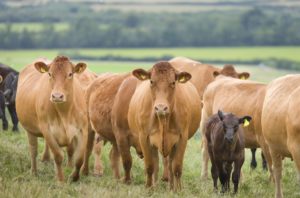Nutrition, health and genetics all play an important part in a sucklers productivity and profitability, where optimising fertility is critical to the success of any herd.
With any livestock system, it is important to meet animal requirements whilst minimising waste. Ensuring optimal dry matter intakes is important when meeting requirements. Monitoring grass growth in the summer and analysing silage in the winter can help inform decision making as well as providing the building blocks of the diet.
Grass and grazing management are key for suckler herds to ensure cows have sufficient and good quality grass. As the season goes on, considering the growth rates and grass quality is important as growth is likely to drop as grass becomes more mature, leading to a forage source that has increased fibre and reduced energy levels. Also do not forget about those first time calvers, they are likely to have greater demands compared to mature suckler cows as they may still be required to gain weight as well as growing a calf.
The hormones associated with fertility and nutrition are closely linked, with dietary energy status being a key factor limiting reproductivity when cows experience severe negative energy balance. Nutrition before calving is as important as nutrition post-calving, particularly when managing metabolic disease. Energy balance post-calving is key to promoting ovulation, where the last 6 weeks of pregnancy through to the first 6 weeks after service is critical to promote oocyte (egg) viability and embryo survival. If excessive weight loss occurs, conception rates and cows holding may be a problem.
Minerals
Mineral supplementation throughout the production cycle is important to not only support cow health but also for the unborn calf. Copper, selenium, iodine and vitamin E are important for fertility with iodine and selenium essential for calf vitality. Undertaking minerals audits with your NWF Sales Specialist and asking your vet to take bloods from some cows is a sensible way to understand the mineral status of your stock. Balancing mineral status can help to improve efficient herd performance and therefore farm profitability.
At 4-6 weeks before calving, moving to a dry cow mineral can help reduce the incidences of slow-calvings, milk fevers and other metabolic issues seen around this stressful period. Things to look for in a dry cow mineral are high levels of magnesium, at least 12% and low levels of calcium, no more than 5% in a powdered mineral. This will help the mobilisation of calcium postcalving and reduce the incidence of milk fever. On forage-based diets mineral antagonists such as iron and molybdenum can be high, adding some alternative sources of trace elements such as Optimins and Hydroxy minerals can help to increase bioavailability.
For further information on maximising your suckler herd, get in touch with your NWF Sales Specialist or click HERE to view our Beef Feeds & Associated Products.
By NWF Technical Advisor, Beth Howells.
